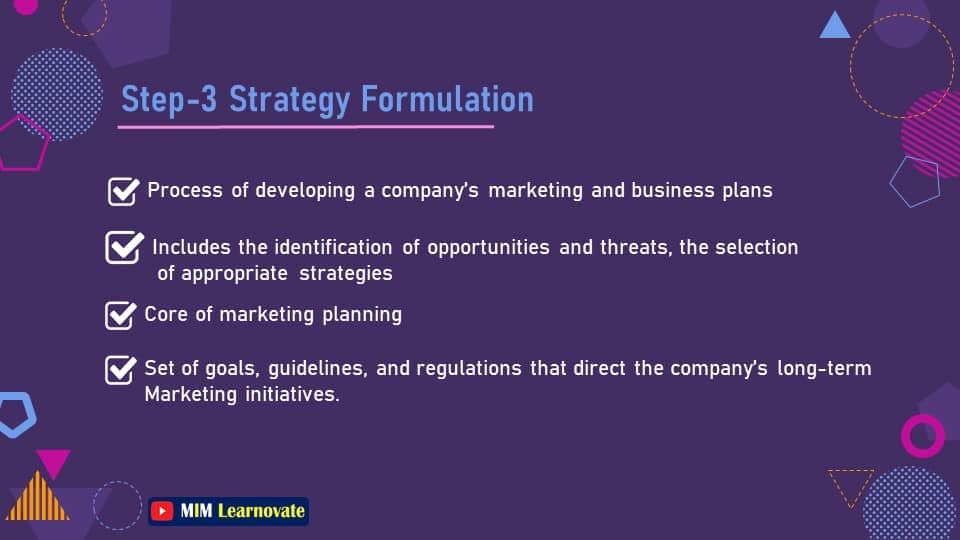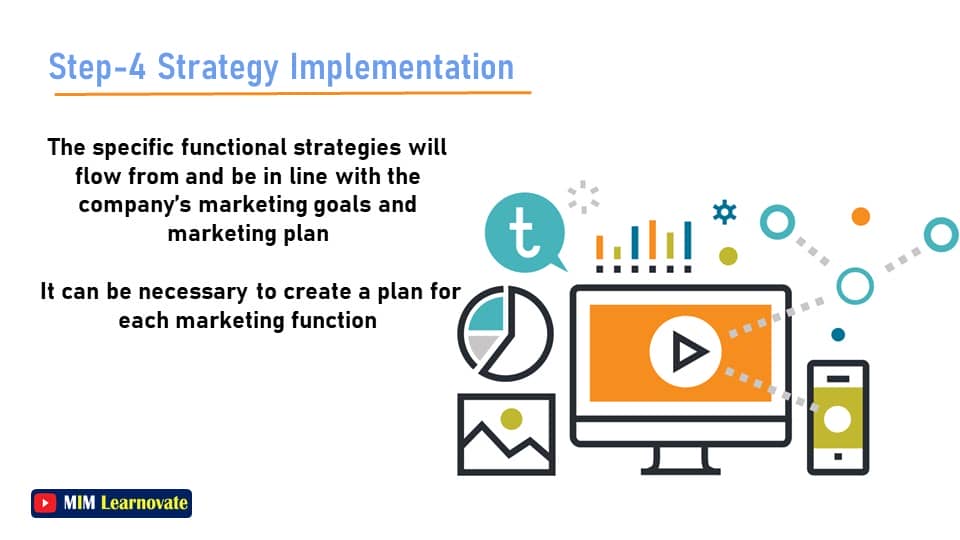In this article you will learn about strategic planning and 5-Step process for strategic marketing planning.
Strategic marketing planning is a process that any business can use to create a comprehensive, integrated, and cohesive marketing plan. By taking the time to develop a strategic marketing plan, businesses can ensure that all of their marketing efforts are working together to achieve their overall objectives.

Strategic Planning
It is an organization’s process of defining its strategy or direction and making decisions on allocating its recourses to pursue this strategy.
Strategic Planning is an art of formulating business strategies, implementing them and evaluating their impact based on organizational objectives.
Strategic Planning is the process of setting goals, identifying and making decisions on how best to achieve them. It is a fundamental tool for any organization, business.

5-Step process for Strategic Marketing Planning
Strategic Marketing Planning involves these five steps.
1- Mission and objectives
2- Environmental Scanning
3- Strategy Formulation
4- Strategy Implementation
5- Control and Evaluation

1- Mission and objectives
The first step in the strategic planning process is to identify the organization’s mission and vision. This is a brief statement that defines what the company plans to achieve.
The mission is the reason for the organization’s existence.
What it does and Why it exists ?
The vision is the long-term goal of where the organization wants to be.
Mission and vision describes the purpose and direction of the organiztion
Corporate Objectives are organization’s goal in which firms leaders define financial and strategic objectives.
. The objectives are specific goals that support the mission statement and help the company achieve its goals.
Some objectives might include increasing market share, launching new products, entering new markets, or increasing brand awareness. To develop effective objectives, businesses need to understand their target market, their competition, and their own strengths and weaknesses. Only then can they set realistic and achievable goals.
Read More: Target Market Strategies | Undifferentiated, Differentiated, Concentrated Marketing


Learn More: Product Attributes in Marketing | Types | Examples
2- Environmental Scanning
Once the mission and vision are established, the next step is to assess the current situation. This includes looking at both internal and external factors that may impact the organization’s ability to achieve its goals.

Environmental scanning is a critical task for businesses. By keeping abreast of current and future trends, businesses can make informed decisions about where to allocate resources in order to best take advantage of opportunities and minimize threats.

Learn More: Product Classification | Consumer, Industrial Products | Examples
External Factors
External Factors are those factors that don’t have immediate impact on the performance and cannot be controlled by the organization. For Example Legislation
Techniques used: PESTLE, Opportunities , Threats
Internal Factors
Internal Factors are key factors and capabilities of an organization’s recourses , departments, products, services finance etc. For Example Marketing
Techniques used: Portfolio Analysis ( BCG ) , Financial Analysis, Marketing Audit
By taking the time to periodically scan their environment, businesses can stay ahead of the curve and make strategic decisions that will help them remain competitive.
Learn More: Product Life Cycle (PLC) Stages, Strategies and Examples
SWOT Analysis
SWOT is the scan of internal and external environment which is an important part of strategic planning process
It includes environmental factors that are internal to the firm that is strength (S) or weakness (W) and those factors that are external to the firm that can be classified as Threats (T) or Opportunities (O).

A SWOT analysis is a tool that can be used to assess a company’s competitive position. The analysis involves four key areas: strengths, weaknesses, opportunities, and threats.

Strengths are internal factors that give a company an advantage over its competitors.
Weaknesses are internal factors that put a company at a disadvantage relative to its competitors.
Opportunities are external factors that present themselves as potential areas for growth or expansion for the company.
Threats are external factors that could negatively impact the company’s business model or competitive position.
Learn More: Product Positioning | Positioning Strategies | Examples
| Strengths ✔ Strong brand names ✔ Good Reputation among customers ✔ Access to High Quality natural recourses ✔ Favorable Access to distribution networks | Weaknesses ❌ Weak brand names ❌ Poor Reputation among customers ❌ Lack of access to High Quality natural recourses ❌ Lack of access to distribution networks |
| Opportunities ✔ Unfulfilled customer need ✔ arrival of new technologies ✔ removal of international trade barriers ✔ loosening of regulations | Threats ❌ Emergence of competitors ❌ Emergence of substitute products ❌ New regulations ❌ Increased trade barriers |

Learn how these companies conducted SWOT Analysis:
The goal of a SWOT analysis is to help companies identify potential areas of improvement and make informed decisions about where to focus their resources.

Learn More: New Product Development Process: 8 Stages
3- Strategy Formulation
Given information rom the environmental scan, the firm should match its strengths to the opportunities that it has identifies while addressing its weaknesses and external threats.
Strategy formulation is the process of developing a company’s marketing and business plans. It includes the identification of opportunities and threats, the selection of appropriate strategies.
Marketing strategy formulation is the core of marketing planning. A marketing strategy is a set of goals, guidelines, and regulations that direct the company’s long-term marketing initiatives.
Simply put, marketing strategy is the entire, unbeatable plan created especially for reaching the firm’s marketing objectives. The marketing objectives set forth what the firm hopes to accomplish, and the marketing strategy offers the method for doing so.


4- Strategy Implementation
The selected strategy is implemented by means of programs and procedures. Implementation involves organization of firm’s recourses and motivation of staff to achieve objectives.
Read More: Market Segmentation | Types, Benefits of Segmentation
The specific functional strategies will flow from and be in line with the company’s marketing goals and marketing plan. If the intricate functional plans are created carelessly, even the strongest marketing strategy could fail in the marketplace. It can be necessary to create a plan for each marketing function.


5- Evaluation and Control
The implementation of the strategy must be monitored and adjustments should be made as needed.
Read More: STP Process | Segmentation, Targeting, Positioning
The business must continuously check to see if everything is operating according to plan. If this control point isn’t present, it won’t be feasible to evaluate successes or failures or identify and address the strategy’s weak areas. Going back to Step 1 again, may be necessary if revisions are needed.

Conclusion
As the world of marketing changes, so do the strategies that businesses use to reach their target audiences. While some companies are content to stick with tried-and-true marketing methods, others are always looking for the latest and greatest way to get their name out there.
Read More: Marketing Environment | Micro & Macro Environment
However, no matter what size your company is or what industry you’re in, one thing remains constant: all businesses need a strategic marketing plan.

Creating a strategic marketing plan is the first step to ensuring that your marketing efforts are effective and efficient. Without a plan, it’s easy to waste time and money on tactics that don’t work or don’t fit your overall goals. But with a solid plan in place, you can make the most of your marketing budget and make sure that every dollar you spend is working toward your bottom line.

Branding in Marketing 2023 | Tips for Small Businesses – MIM Learnovate




1 Comment
I like this blog its a master peace ! Glad I observed this on google .